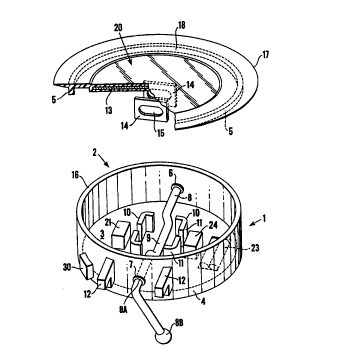Note: Claims are shown in the official language in which they were submitted.
-12-
CLAIMS
1. A device for indicating and/or preventing
displacement or for indicating and/or limiting the
overall displacement of a movable member (32, 38, 39, 42,
49, 50, 52) from a preset position, wherein the device
(1) is adapted to be selectively positionally mountable
to the movable member.
2. A device as claimed in claim 1, and characterised
in that the device (1) is adapted to enable predetermined
variations in allowable displacement of the movable
member (32,38,39,42,49,50 52) prior to preventing further
displacement of the member and/or for providing an
indication of any such displacement of the movable
member.
3. A device adapted for releasable attachment to a
movable member (32,38,39,42,49,50 52), at such position
as to be able to contact a non-movable region relative to
which the movable member is displaceable following a
predetermined amount of displacemen of the movable
member, the device (1) including means (24) for producing
an indication that such allowed amount of displacement
has been attained.
4 A device as claimed in claim 1, 2 or 3, and
characterised in that wherein the device (1) is responsive
is a linear displacement of the movable member
(32,38,39,42,49,50 52).
5. A device as claimed in claim 1, 2 or 3, and
characterised in that the device (1) is arranged to
respond to an angular displacement of the movable member
(32,38,39,42,49,50 52).
-13-
6, A device as claimed in claim 1, 2 or 3, and
characterised in that the device (1) is responsive both
linear displacements and angular displacements of the
movable member (32,38,39,42,49,50 52).
7, A device as claimed in any one of claims 1 to 5,
and characterised in that the device (1) is arranged on
operation to provide an indication of unauthorised
displacement of the movable member (32,38,39,42,49,50
52)in the form of an an audible and/or visual warning
signal.
8, A device as claimed in any one of the preceeding
claims, and characterised in that the device includes a
main body (2,3,4) and a device mounting part (5,17,18)
adapted for positional adjustment relative to the main
body (2,3,4) upon actuation of a device operation setting
element (8), and in that the device mounting part
(5,17,18) is adapted for attachment to a smooth surface
by means of a suction induced sealing effect produced
between the device mounting part and said surface.
9, A device as claimed in claim 8, and characterised
in that the device mounting part includes a plate (13)
encapsulated in an elastomeric covering (20) providing an
exposed outer surface, the covering including an
outwardly extending peripheral region (17) which is
arranged in conjunction with the remainder of the exposed
outer surface (18) to define a suction/vaccuum type
sealing surface.
-14-
10. A device as claimed in claim 8 or 9, and
characterised in that the device mounting part (5,17,18)
is operationally coupled to the main body part by way of
a rotatable cranked lever arrangement(8,9), the
arrangement being such that the lever arrangement can be
actuated in such manner as to pull the device mounting
part (1,17,18) towards the main body and thereby to
produce, when the device mounting part has been placed
against a smooth surcface a suction induced sealing
effect between the device mounting part and said surface.
11. A device as claimed in any one of the preceeeding
claims, and characterised in that the device (1) includes
an electronic circuit including means (21) responsive to
linear displacements of the device.
12. A device as claimed in any one of the preceeeding
claims, and characterised in that the device includes an
electronic circuit including means (26) responsive to
angular displacements of the device.
13. A device as claimed in any one of the preceeeding
claims, and characterised in that the device includes an
electronic circuit including means (21,26) responsive to
both linear and angular displacements of the device.
14. A device as claimed in claim 11 or 13, and
characterised in that the device responsive to said
linear displacements is a trembler switch (21).
15, A device as claimed in claim 12, 13 or 14, and
characterised in that the device responsive to said
angular displacements is a tilt responsive switch (26).
-15-
16. A device as claimed in any one of claims
11 to 15, and characterised in that the circuit includes
a timer unit (27) for enabling selectice control over the
duration of operation of electronic circuit in producing
said indication.
17. A device as claimed in claim 16, and
characterised in that the circuit includes operation
repeater means (28), whereby the device can be caused to
repeat its indication from time to time until the device
has been monitored.
18. A method of indicating and/or preventing
displacement or for indicating and/or limiting the
overall displacement of a movable member (32, 38, 39, 42,
49, 50, 52) from a preset position including the step of
positionally mounting to the member a device (1) adapted
to be selectively positionally mountable to the member,
the device including means (21,26) for producing an
indication that an allowed amount of displacement has
been effected.
